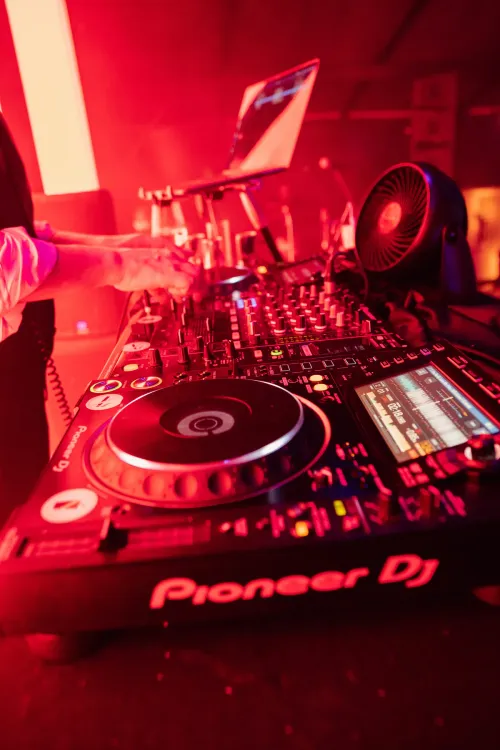Mixing in music production is the process of combining individual tracks, adjusting their levels, applying various audio effects, and shaping the overall sound to create a balanced and cohesive final mix.
The goal is to create a sonic landscape where each instrument plays a distinct role, contributing to the music’s overall emotional impact and atmosphere.
Why is Mixing Important?
Mixing is crucial for several reasons:
- Clarity and definition. It brings clarity and definition to each instrument or vocal part, preventing them from clashing or muddying the overall sound.
- Balance and cohesion. It establishes balance and cohesion within the song, ensuring each element contributes to the overall sonic landscape.
- Emotional impact. It shapes the emotional impact of the music, conveying the desired mood and atmosphere to the listener.
- Professional quality. It elevates the overall quality of the music, transforming it from a rough arrangement into a polished and professional-sounding piece.
Mixing vs Mastering
While mixing and mastering are often used interchangeably, they represent distinct phases in the music production process. Mixing focuses on adjusting individual tracks—setting their levels, applying effects, and creating a stereo image. On the other hand, mastering deals with the final polish of the entire mix, preparing it for distribution. Think of mixing as crafting the ingredients of a recipe, while mastering is the final presentation of the dish.
Mixing Tools and Techniques
Various tools and techniques are employed to achieve a balanced and polished mix. Here are some of the essential ones:
- EQ (Equalization). EQ allows you to boost or cut specific frequencies, enhancing clarity and separating different instruments. For instance, you might use EQ to give more brightness to a vocal or to clean up the muddiness in a bass guitar.
- Compression. Compression helps control the dynamic range of individual tracks, ensuring that no element is too loud or quiet. It adds consistency, making the mix more cohesive. Imagine it as a musical volume stabilizer.
- Levels and panning. Levels determine the volume of each track while panning positions them within the stereo field, spreading them across the left and right speakers.
- Reverb and delay. Reverb and delay add depth and dimension to the sound, simulating the natural reflections and echoes that occur in real-world environments.
- Saturation. Saturation introduces harmonics and warmth to your mix. It mimics the pleasing distortion of analog equipment, adding character to digital recordings.
- Automation. Automation allows you to dynamically adjust parameters over time. For example, you can automate the volume of a vocal to emphasize certain phrases or create a gradual build-up.
How to Approach Mixing
Mixing requires a combination of technical expertise, creative vision, and patience. Here are some tips for approaching mixing:
Create a Dedicated Studio Space
Establish a consistent and quiet environment for mixing. Invest in a pair of decent studio monitors if possible, as they provide accurate representation, helping you make informed decisions about your mix. Quality headphones can be a reliable alternative if studio monitors are out of reach.
Educate Your Ears with Reference Tracks
Regularly listen to professionally mixed tracks in your genre. This helps train your ears to recognize the nuances of a well-balanced mix. Use these reference tracks as a guide for achieving a comparable tonal quality in your own mixes.
Test Across Different Playback Systems
Recognize that listeners will experience your music through various devices. Ensure your mix translates well on different platforms, such as headphones, car speakers, and consumer-grade speakers. This ensures your mix maintains its quality across a diverse range of listening environments.
Focus on Fundamental Tools
Start with the basics: pay attention to levels, panning, and EQ. Set appropriate levels for each element, position them in the stereo field, and use EQ to carve out space for each instrument. As you gain confidence, gradually explore more advanced tools and techniques.
Experiment with Automation
Automation adds dynamic movement to your mix. Experiment with automating volume, panning, and effects over time to create interest and emphasize key elements. Don't be afraid to try different approaches, and trust your ears.
Consistent Practice and Patience
Becoming proficient in mixing takes time and practice. Approach each mix as a learning opportunity. Be patient, experiment with different techniques, and learn from successes and challenges. Consistency is key to developing your mixing skills over time.
FAQs
What equipment do I need to mix music?
The essential equipment for mixing music includes:
- A computer with a digital audio workstation (DAW) software
- Studio monitors for accurate sound reproduction
- Headphones for reference listening
Do I need expensive equipment to start mixing?
While quality gear can enhance your mixing experience, you can achieve great results with budget-friendly equipment. Focus on developing your skills and ear for now. Investing in a decent pair of headphones and entry-level studio monitors is a good starting point.
How long does it take to become proficient at mixing?
It varies, but consistent practice and experimentation are crucial. Don't rush the process—each mix is a learning opportunity. Over time, you'll develop a better understanding of your tools and refine your skills.
How long does it take to mix a song?
The mixing process can vary greatly depending on the complexity of the song, the experience of the mixer, and the desired level of polish. It can range from a few hours to several days.
What are some common mixing mistakes beginners make?
Some common mixing mistakes beginners make include:
- Overusing EQ or compression
- Neglecting panning and stereo placement
- Not using reference tracks
- Not testing the mix on different speaker systems
What should I do if my mix sounds muddy?
Muddiness often results from conflicting frequencies. Use EQ to carve out space for each instrument by boosting essential frequencies and cutting unnecessary ones. Pay attention to the low end, and make sure instruments like bass and kick drum are well-defined without overwhelming each other.
Is there a specific order to apply effects in mixing?
A: While there's no strict rule, a common approach is to start with corrective processing (like EQ), then move to dynamic processing (compression), spatial effects (reverb, delay), and finally, creative effects. However, feel free to experiment and trust your instincts.








